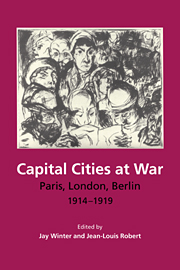Book contents
- Frontmatter
- Contents
- Note on joint authorship
- List of figures
- List of tables
- Part 1 Premises
- Part 2 The Social Relations of Sacrifice
- Part 3 The social relations of labour
- 5 The transition to war in 1914
- 6 The labour market and industrial mobilization, 1915-1917
- 7 The transition to peace, 1918-1919
- Part 4 The social relations of incomes
- Part 5 The social relations of consumption
- Part 6 Urban demography in wartime
- Part 7 Towards a social history of capital cities at war
- Statistical appendix and tables
- Bibliography
- Index
6 - The labour market and industrial mobilization, 1915-1917
Published online by Cambridge University Press: 15 December 2009
- Frontmatter
- Contents
- Note on joint authorship
- List of figures
- List of tables
- Part 1 Premises
- Part 2 The Social Relations of Sacrifice
- Part 3 The social relations of labour
- 5 The transition to war in 1914
- 6 The labour market and industrial mobilization, 1915-1917
- 7 The transition to peace, 1918-1919
- Part 4 The social relations of incomes
- Part 5 The social relations of consumption
- Part 6 Urban demography in wartime
- Part 7 Towards a social history of capital cities at war
- Statistical appendix and tables
- Bibliography
- Index
Summary
Introduction
After the initial crisis of 1914-1915, which to different degrees disturbed the labour market in the three capital cities, their urban populations entered a period of massive mobilization. Given the presence of a highly skilled labour force, transport and communications networks, and central political and financial institutions, Paris, London, and Berlin were repositories of economic assets essential to the war effort.
Three processes governed the reorganization of the metropolitan labour market: the expansion of industrial activity to fulfil war contracts for goods ranging from shells to military uniforms; the rapid growth in urban activity in general, such as food and fuel provision for the civil population; and the concomitant recession in consumer-goods production. The outcome was an unprecedented social and occupational reordering of production, which changed not only the labour market but the very appearance of the three capital cities themselves.
We should note that on the eve of the war these cities were very large reservoirs of labour. For the Department of the Seine the overall estimate of the number of wage-earners in 1914 was 1,750,000. The order of magnitude of the labour force in Greater Berlin was similar. There were more than 1,400,000 workers registered in Krankenkasse (national health-insurance bureaux) in July 1914.2 A London County Council (LCC) estimate for July 1914 gives a figure of close to 1,400,000 workers in the twenty-eight metropolitan boroughs under the jurisdiction of the LCC. These are almost certainly underestimates, given the exclusion of domestic workers and many women workers whose employment went unreported before the war.
- Type
- Chapter
- Information
- Capital Cities at WarParis, London, Berlin 1914–1919, pp. 164 - 195Publisher: Cambridge University PressPrint publication year: 1997

